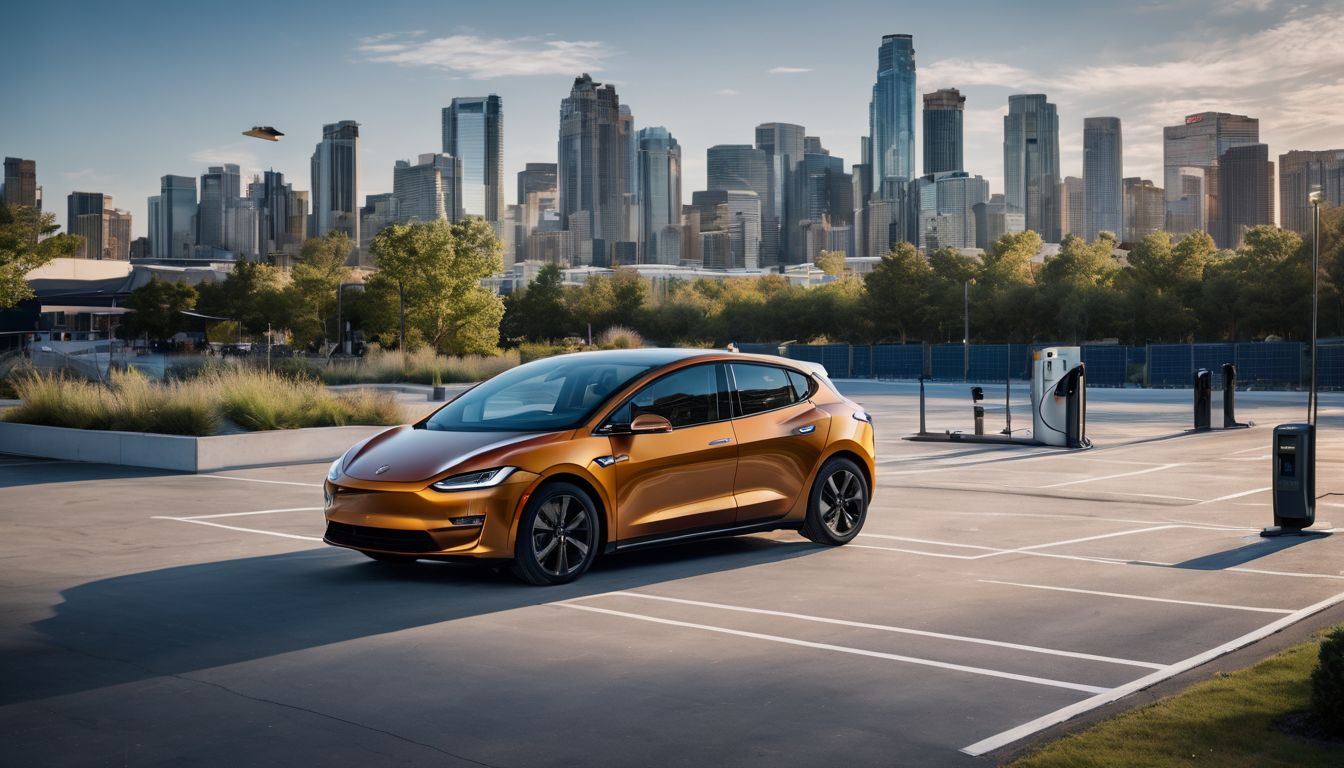We’ve all experienced the inconvenience of a dead car battery, often at the most inopportune moments. Just like you, we understand how aggravating it is to find oneself stranded, particularly when you discover that traditional batteries are not quite up to par with the demands of contemporary vehicles.
Worry not though, for our comprehensive exploration into the dynamic realm of automotive batteries promises to equip you with insights for powering your vehicle more effectively and with an eye on sustainability.
So let’s embark on this journey together to supercharge your knowledge!
Key Takeaways
- Automotive batteries have progressed from lead-acid to lithium-ion, making electric vehicles more powerful and efficient.
- AGM batteries are gaining popularity for their energy density and performance, suitable for hybrid vehicles with start-stop systems.
- Solid – state batteries hold the potential for higher energy density and faster charging, leading the future of electric car battery technology.
- Recycling plays a vital role in automotive battery sustainability by recovering valuable materials and reducing environmental impact.
- Advancements like aluminum die casting improve vehicle manufacture by reducing weight without compromising safety or performance.
Evolution of Automotive Batteries
The automotive industry has seen a remarkable evolution in battery technology, moving from traditional lead-acid batteries to more advanced lithium-ion ones. AGM batteries have also become increasingly popular due to their efficient energy storage capabilities.
From Lead-Acid to Lithium
In the journey of battery evolution, we’ve shifted from cumbersome lead-acid batteries to svelte lithium-ion powerhouses. These newer batteries pack more punch for electric vehicles (EVs), meeting the escalating vehicle power needs with ease.
They charge faster, last longer, and shave off considerable weight compared to their ancestors, helping cars zip around without a frequent need to recharge.
Lithium-ion batteries have not just propelled EVs into the mainstream; they also play a key role in renewable energy systems. With their ability to efficiently store and release electricity, these rechargeable wonders support our drive towards cleaner transport options.
They’re essential in making sure that every kilometre we travel contributes less to environmental harm and leans more on sustainable practices.
Rise of AGM Batteries
AGM batteries, or Absorbent Glass Mat batteries, have gained popularity in automotive applications due to their spill-proof design and maintenance-free operation. These advanced lead-acid batteries utilise a woven glass mat to hold the electrolyte solution, which allows for higher energy density and improved performance.
AGM batteries are known for their ability to deliver high currents on demand, making them ideal for start-stop systems and regenerative braking in hybrid vehicles. Moreover, they offer better resistance to vibration and deep discharge cycles compared to traditional lead-acid batteries.
The rise of AGM batteries has significantly contributed towards improving fuel efficiency and reducing emissions in vehicles. Furthermore, their reliability makes them an attractive option for environmentally conscious individuals looking to support sustainable transportation solutions without compromising on performance or convenience.
Advancements in Lithium-Ion Batteries
Moving on from the rise of AGM batteries, let’s delve into the remarkable advancements in lithium-ion batteries that have revolutionised automotive battery technology. The development of lithium-ion batteries has significantly enhanced energy storage capacity and longevity, making them a pivotal component in electric vehicles (EVs) and hybrids.
These high-performing rechargeable batteries boast higher power density, longer lifespan, and faster charging capabilities compared to traditional lead-acid or nickel-cadmium options.
As a result, they offer an efficient and sustainable solution for environmentally conscious individuals seeking to reduce their carbon footprint through the adoption of electric vehicle technology.
Lithium-ion batteries play a critical role in driving forward the green transportation movement due to their impressive energy retention abilities and suitability for various automotive applications.
Future of Electric Car Batteries
The future of electric car batteries is moving towards solid-state batteries, which promise higher energy density and faster charging capabilities. Additionally, there is a growing emphasis on recycling and sustainability in battery production to minimise environmental impact.
Solid-State Batteries
Solid-state batteries represent the next big leap in automotive battery technology. They promise improved energy density, faster charging times, and enhanced safety compared to traditional lithium-ion batteries.
The absence of liquid electrolytes also means that solid-state batteries are less prone to overheating or catching fire, addressing one of the main concerns with current battery technology.
These advancements bring hope for longer-range electric vehicles with shorter charging times, making them more convenient and practical for everyday use. Additionally, the potential for solid-state batteries to be more environmentally friendly due to their longer lifespan and easier recyclability aligns with our commitment to sustainability and conservation efforts.
Recycling and Sustainability
Moving on from solid-state batteries, let’s delve into the crucial aspects of recycling and sustainability in automotive battery technology. As environmentally conscious individuals, we understand the significance of responsible disposal and reuse of electric vehicle batteries.
Recycling processes for lead-acid and lithium-ion batteries involve extracting valuable materials such as lead, nickel, cobalt, and lithium to be repurposed or incorporated into new battery production.
This reduces the demand for mining raw materials while minimising environmental impact, aligning with our commitment to conservation.
Impact of Electric Vehicle Technology
The impact of electric vehicle technology goes beyond just the batteries. Aluminium die casting is revolutionising car manufacturing, while V2X cybersecurity is crucial for protecting connected vehicles from cyber threats.
These advancements are shaping the future of automotive technology and sustainability.
Aluminum Die Casting
Aluminum die casting plays a critical role in the advancement of electric vehicle technology. With its lightweight yet durable properties, aluminum die casting is widely used in the manufacturing of electric car components, including battery housings and structural parts.
The process allows for intricate designs and precise tolerances, enhancing the overall efficiency and performance of electric vehicles. By incorporating aluminum die casting into electric vehicle production, manufacturers can significantly reduce the weight of vehicles while maintaining strength and safety standards.
The integration of aluminum die casting not only contributes to lighter electric vehicles but also supports sustainability efforts through efficient energy use during production. Additionally, aluminum’s high recyclability aligns with environmentally conscious initiatives within the automotive industry, promoting a more eco-friendly approach to vehicle manufacturing.
V2X Cybersecurity
V2X cybersecurity protects electric vehicles from potential cyber threats. It safeguards the vehicle-to-everything (V2X) communication, ensuring secure data exchange between the car and its environment.
Implementing robust V2X cybersecurity measures is essential to maintaining the safety and privacy of electric car users, making it a crucial aspect of automotive technology development.
Cybersecurity in V2X technology can prevent unauthorised access to an electric vehicle’s systems, protecting sensitive information and ensuring smooth operations. Encryption and authentication protocols play a vital role in securing V2X communication channels, contributing to a safer and more reliable driving experience for environmentally conscious individuals who value sustainable transportation solutions.
Conclusion
In conclusion, automotive battery technology has transformed from lead-acid to lithium-ion, revolutionising electric vehicles. Advancements like AGM and solid-state batteries have boosted performance and sustainability.
The future promises even more innovation with solid-state batteries and enhanced recycling efforts. As electric vehicle technology continues to evolve, the impact on components like aluminium die casting is significant.
Cybersecurity in V2X communication is crucial for a seamless electric vehicle experience.
FAQs
1. How has automotive battery technology changed over time?
Over the years, vehicle batteries have evolved from lead-acid batteries to nickel-cadmium, and now we have advanced lithium-ion and solid-state batteries powering electric vehicles (EVs).
2. What are some breakthroughs in electric vehicle battery technology?
Electric car battery development has seen major breakthroughs like lithium-ion batteries that hold more charge, and solid-state batteries which promise even greater energy storage and safety.
3. Why are lithium-ion batteries popular in electric vehicles?
Lithium-ion batteries are favored for electric vehicles because they’re lighter, recharge faster, and last longer compared to old lead-acid or nickel-cadmium varieties.
4. What role do battery management systems play in EVs?
Battery management systems are crucial as they protect the car’s battery components by managing temperature control, voltage regulation, and ensuring safe charging practices at electric vehicle charging stations.
5. Are solid-state batteries really better than current EV batteries?
Solid-state batteries could be a game-changer with benefits such as higher energy density for longer range, improved safety features, and potentially quicker charging times than existing lithium-ion electric vehicle (EV) batteries.





